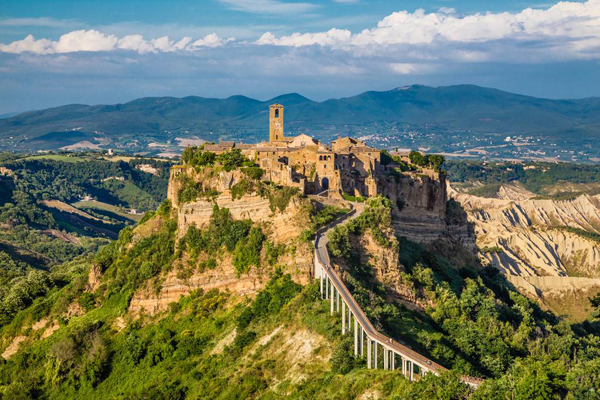Brief description
Bolognolizio (Italian: Civita di Bagnoregio) is a village in the province of Viterbo in the Italian region of Lazio. Bagnoregio dates back 2,500 years and was founded by the Etruscans as a village. The village is also known as the City in the Sky because of its isolation on top of a hill and its isolation from the outside world. Bailurizio is located on an isolated mountain, on a very precipitous terrain, and is known as a ‘dying village’ due to the fact that it is located on a mountain that is constantly in danger of collapsing due to falling rocks and buildings. But its relative isolation has also saved it from war damage. Nowadays, Bailurizio has been developed for tourism. It has been chosen as one of the most beautiful villages in Italy.

Belluligio
The history of the town
The history of Belluligio dates back to prehistoric times, with large burial mounds excavated under the city proving that Etruscans settled here more than 2,000 years ago, and the city’s name appears for the first time in a letter from the Roman Emperor Gregry to Bishop Chuiusi Ecclesio in 599 AD. Legend has it that the waters of its thermal springs cured the Lombard kings of skin diseases, that Charlemagne, King of Lombardy, returned it to the Pope in 774 AD, that it was granted as a free city in the 12th century, and that it experienced a period of cultural prosperity before an outbreak of plague in 1348 almost destroyed the whole city, with 500 people said to have died in a single day.
In 1495 the townspeople ousted the Orvieto monarch, Monaldeschi, and in 1592 a popularly elected government was formed to end the long-standing control of the Church. 1867 saw the famous Bolognese War, in which the papal troops fought against the Garibaldi militia, after which the town was incorporated into the Kingdom of Italy. This is a telephoto shot of the town of Orvieto on the opposite side of the hill, with the famous Orvieto Cathedral in the middle of the spire.
Bailurizio was already a parish in the 12th century, and the Cathedral of St. Donato in the square was built in the 13th century in the Renaissance style. A few broken pillars in front of the door indicate that the older version of the church was more luxurious, with a colonnade in front of the door and an exterior that was remodelled in the 16th century. The church houses the relics of St. Donato, a 6th-century martyr, as well as those of St. Victoria, a 3rd-century martyr widely revered in the area. To the right of the church is the Renaissance Alemanni Palazzo, which belonged to a wealthy local family and was converted into a museum some years ago, with a large wine cellar in the basement where some vintage wines are kept (the area is surrounded by grapes and is one of Italy’s wine producing regions). The streets are lined with buildings of medieval character: fortified walls, arched lintels and stone staircases built outside. The inhabitants were mainly engaged in agriculture and the houses were similar in structure, with stables, laundry and kitchen on the ground floor, usually bedrooms on the upper floors, but also for storage of grain, and usually a vegetable cellar, a wine cellar or a workshop for processing olive oil in the basement. The houses are so closely spaced that you can reach out on a stone staircase and touch your neighbour across the street. The inhabitants used to open the windows to chat with their neighbours and even pass things around. The house is described as an original medieval building in the town.
Old town attractions
Bailurizio is the birthplace of St. Bonaventure (San Bonaventura, also known as Bonaventura), the important founder of the Catholic Order of St. Francis, who is mentioned in the 14th century by the Italian poet Dante in his poem “The Divine Comedy”. Born in 1221, he spent his youth here and in 1238, when he fell seriously ill, St Francis of Assisi came to visit him and prayed for him, and it was in the small prayer chapel (Bonaventure cavern, converted from an Etruscan cemetery) beneath the house that he miraculously recovered, which he considered to be a sign of divine favour, and from then on he devoted himself to the Church and is regarded as a saint. He was appointed Cardinal and Archbishop of Abano by the Pope in 1273, and died suddenly the following year while preparing for the Council of Lyon. A church dedicated to him was built in 1525 on the site of his home, which was later lost in the earthquake. At this time a 17th-century painting showing the image of St. Bonaventure protecting the city is still in the church of St. Donato.
With media attention and the involvement of research institutes and environmental organisations, the government began to take this untouched corner of the city seriously. In 1988, an association of public and private institutions was set up to launch the “Civita Project”, a scientific approach to the conservation of the town. The town’s unique location, the absence of noise, and the fact that the town is a very quiet place, are all part of this. The unique location, the natural environment, the absence of noise and the beauty of the landscape have attracted people who want to buy property, and some houses have been converted into holiday homes. The formerly desolate and decadent town has become a favourite of the film industry, with films such as Contestazione Generale (Italy), The Passion of the Christ, Pinocchio and the Italian-Brazilian TV series Terra Nostra all choosing the town as a location. This street scene was featured in Pinocchio.